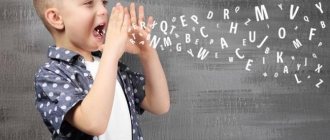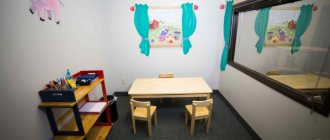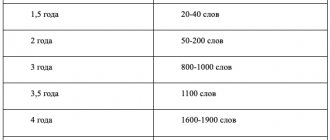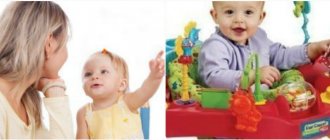Article:
Most parents believe that it is enough to teach their child the letters, and he will begin to read and write correctly.
But this is a misconception! Practice shows that knowledge of letters does not exclude serious difficulties for schoolchildren when learning to read and write. How much the child worries about the mistakes corrected by the teacher’s red pen! How boring it is to do “Work on mistakes”!
The main cause of errors is impaired phonemic hearing, i.e. the ability to identify and distinguish speech sounds. In order to write correctly, a child needs to imagine that a sentence consists of words, a word consists of syllables and sounds, and the sounds in a word are arranged in a certain sequence.
Therefore, it is important to develop phonemic hearing in a child in preschool age!
Let's get started! Classes should not be boring lessons, but an interesting game. After all, play, being the leading activity of preschool age, allows you to make the learning process accessible and interesting. Our classes will be held in a playful form, but will be educational in nature. In essence, they are “Working on errors”, preventing their occurrence. This kind of “Work on mistakes” is fun to do, and when you come to school, your child will write a dictation without mistakes.
Scientists have proven that even before birth, children hear and react to sounds from the outside world in different ways.
With the birth of a child, these sounds fill his world: the singing of birds and the murmur of water, the sound of the wind and the rustling of leaves. The baby begins to listen to surrounding sounds. But words—speech sounds—are the most significant from his birth. Sounded speech provides the necessary communication and information acquisition for the child.
By listening to words, comparing their sounds and trying to repeat them, the child begins not only to hear, but also to distinguish the sounds of his native language. This ability develops in him gradually. From 2-4 weeks from birth, the baby begins to respond to any sounds. Melodious sounds make him feel satisfied and smile, and sharp sounds (angry voice) make him cry. At 7-11 months the child already responds to the word. Only towards the end of the first year of life does the word first begin to serve as an instrument of communication.
Further, phonemic development occurs rapidly, constantly ahead of the child’s pronunciation capabilities. Already in the third year of life, children can notice incorrect pronunciation among their peers and even try to correct them.
And by the age of 5, a child develops a critical attitude not only to someone else’s speech, but also to his own speech. He is very sensitive to the inaccuracies of his pronunciation, which often manifests itself in a refusal to communicate and to collaborate together. In addition, this necessarily affects the mastery of reading and writing.
Correcting pronunciation deficiencies in children consists of producing sounds and introducing them into speech and at the same time developing phonemic hearing. Without a full perception of sounds, without their clear distinction, the formation of pure speech is impossible.
But even if a child pronounces all the sounds correctly, he often does not distinguish some of them by ear, and this, in turn, greatly complicates and sometimes distorts the understanding of speech, and also manifests itself in errors in writing.
It is much easier to prevent a violation than to correct it. So, work on developing phonemic awareness prepares children to master correct pronunciation and is aimed at preventing grammatical errors.
First of all, find out how the baby perceives and distinguishes sounds. The following simple steps will help with this:
- Invite your child to repeat the syllables after you: sa-sha, sha-sa, ach-ashch, sa-tsa, ra-la, sha-zha. - If a child pronounces some sounds incorrectly, their discrimination is checked as follows: ask him, after hearing a given syllable, to perform some action. For example, if among the syllables sa, tsa, cha the syllable sha is named, the child claps his hands.
- Let's check whether the child distinguishes words that are similar in sound but different in meaning.
- Invite him to choose the desired picture among: beetle - bitch; bom - catfish; bear - bowl; goat - braid; puddle - ski.
- Talk about the meaning of the words: “What is a puddle and what is a ski?”
- The following technique will reveal the degree of development of attention and auditory memory. Invite your child to repeat similar syllables: ta - da - ta, ka - ga - ga, pa - ba - ba, ma - na - na; - repeat similar words: Masha - Dasha - porridge; shadow - day; day - stump; bek - varnish - poppy - so - cancer; beetle - bow - bough - knock.
Difficulties in completing tasks indicate a decrease in phonemic awareness.
Work on the development of phonemic perception begins with the material of non-speech sounds and gradually covers all speech sounds. The tasks are offered in strict sequence, conditionally divided into six stages:
- recognition of non-speech sounds
- distinguishing the height, strength, timbre of the voice on the material of identical sounds, combinations of words and phrases
- distinguishing words that are similar in sound composition
- syllable discrimination
- sound discrimination
- analysis of the sound composition of a word
Let's get started on developing your baby's phonemic awareness!
How is consultation and correction carried out?
Speech deficiencies can be corrected at any age. But we must remember that the earlier a speech disorder was identified, the faster and easier it can be eliminated in classes with a speech therapist.
At the initial lesson in our center, a speech pathologist-defectologist will conduct a speech diagnosis, determine whether there are defects and what are the reasons for their appearance. If necessary, the speech therapist can issue a certificate for the kindergarten or put a mark in the medical record.
After the examination, the specialist will begin corrective work to eliminate the identified speech deficiencies. An individual speech correction course may include speech therapy massage, special speech exercises, work with computer programs and speech therapy probes, articulatory gymnastics, as well as homework to automate new speech skills.
Game "Big or Small"
Place two toy hares (dolls or bears) on the table - a large one and a small one. Explain and show how a big bunny, who has a lot of strength, plays the drum - loudly, strongly, and how a small one - quietly. Then cover the toys with a screen and behind it make loud and then quiet beats on the drum. The kid must guess and show which of the hares just played.
Such games should be played with children starting from 2-3 years old. But even if the baby is already older and you have discovered a decrease in phonemic hearing, you should also start working with these games. Because only gradually increasing the complexity of tasks will achieve maximum efficiency.
Game "Far - Close"
The game is aimed at developing the basic qualities of the voice: strength, height.
An adult shows the child a toy kitten and asks him to listen carefully and remember how it meows when it is close (loud), and how it meows when it is far away (quiet). Then he says “Meow”, changing the strength of his voice, and the baby guesses whether the kitten is meowing close or far away.
Then the baby himself meows at the adult’s signal: “close” - “far”.
A further complication of the game is that the child will distinguish between meows, focusing on the timbre and individual characteristics of the speaker’s voice. The adult explains that the kitten is very afraid of the puppy and meows pitifully, trembling and freezing with fear. The child should meow, feigning fear.
You can play similarly, distinguishing where the steamboat is humming (“oo-oo-oo”) - far (quiet) or close (loud); what kind of pipe is playing - a large one (“oo-oo-oo” pronounced in a low voice) or a small one (“oo-oo-oo” pronounced in a high voice); who is crying - a boy (“a-a-a” in a low voice) or a girl (“a-a-a” in a high voice).
In addition, at this stage it is important to teach the child to determine the tempo of speech by ear. Games for performing movements at an appropriate pace will help with this.
Speech therapist consultations
ARTICULATIVE GYMNASTICS AT HOME
Almost all parents know that gymnastics for arms and legs is needed to make their children dexterous and strong. But not everyone knows that the tongue is the main muscle of the speech organs and gymnastics is simply necessary for it. For correct sound pronunciation, the language must be quite well developed. To prevent the occurrence of defects in the pronunciation of sounds, as well as to mitigate the severity of these shortcomings and facilitate the formation of correct sound pronunciation, it is necessary to start practicing articulatory gymnastics as early as possible.
Already after 7-8 months after the birth of the baby, you can form your lips into a tube, smile, click your tongue, imitating a horse. The sooner the baby learns to click his tongue, the faster sounds that require an upper elevation of the tongue [w, g, r, l] will appear in his speech.
There is an opinion that articulatory gymnastics is not such an important, frivolous activity that you don’t have to do. However, it is not.
Systematic implementation of articulation exercises allows you to:
- prepare the articulatory apparatus for independent development of sound pronunciation;
- overcome speech defects faster;
- bring the tone of the muscles of the lips, cheeks and tongue back to normal.
Types of articulation exercises and rules for doing them at home
There are several basic rules for achieving the effect of articulation gymnastics at home:
- You should exercise daily for 7–10 minutes;
- all exercises are carried out in front of a mirror;
- all exercises are carried out in the form of a game;
- at first the exercise is carried out slowly, slowly, 4 – 5 exercises per day, then every day we add one new exercise;
- Each group of sounds has its own articulation complexes, which will be provided to you by a speech therapist.
Now let's look at what articulation exercises there are. Articulation exercises are divided into static and dynamic.
Static exercises are exercises where the child performs a certain position, the position of the cheeks, lips, and tongue. These are the following exercises:
- "fence";
- "window";
- "tube";
- "cup";
- "pancake";
- "needle";
- "slide";
- "sail".
Static exercises should be held by the child for 5 - 10 seconds, that is, it is not enough to show, the main thing is to be able to hold the pose. For example, we tell a child: “you will do the exercise, and I will count.”
Dynamic exercises are exercises where correct movements of the cheeks, lips, and tongue are necessary. These are exercises such as:
- "watch";
- "swing";
- "horse";
- “brushing our teeth”;
- “delicious jam”;
- "drummer" and others.
These exercises are also carried out by counting, only with each count the child needs to change the position of the cheeks, lips or tongue.
Organizing articulation gymnastics at home
Before you start doing articulation exercises, you must find out how your child navigates in space: can he show what is on the right, left, in front, behind, above, below; whether he distinguishes between right and left hands. Without this, performing articulatory gymnastics is impossible or extremely difficult for the child.
Talk about the upcoming exercise using game techniques. Demonstrate the correct execution of the exercise.
Performing articulatory gymnastics will not cause you much difficulty, but will bring great benefits to your child and will allow you to monitor his progress. Parents often complain that children do not want to do articulation exercises while sitting in front of a mirror. At home, you can use various playful ways to strengthen articulatory motor skills.
Games with cotton balls and bottles, candles
"Air Football"
Stretch your lips forward with a “tube” and blow for a long time on the ball (lays on the table in front of the child, driving it between two cubes. Options depend on your imagination. You can offer the child to blow on a pinwheel, small toys that easily roll on the table, cotton wool (blow off with palms).
"The Singing Bottle"
A directed air stream can be produced well if you invite the child to blow into a small, clean bottle (from the drops). When an air stream hits the bottle accurately, a peculiar humming or whistling sound is heard (“steamboat humming”). Children really like this. Be careful not to puff out your cheeks.
"Candle"
Buy small colorful candles and play with them. You light candles and ask the child to blow on a blue candle, then on a yellow candle, etc. You need to blow slowly, the inhalation should not be noisy, and you cannot puff out your cheeks. First, you can bring the candle closer to the child, then gradually remove it.
"Focus"
Smile, open your mouth slightly, place the wide front edge of your tongue on your upper lip so that its side edges are pressed together and there is a small groove in the middle. Then blow gently upward onto your nose.
"Sweet exercise"
You might be surprised, but the round sweet lollipop is an excellent speech therapy simulator. Unwrap the candy canes and let's play a little.
Squeeze the lollipop with your lips and try to hold it for 5-10 seconds.
Holding the lollipop with your lips, try moving the stick first from top to bottom, then from side to side.
Open your mouth slightly, lips parted into a smile, make a cup, put lollipop in the cup and try to hold the lollipop with your tongue only.
During the performance of articulatory gymnastics, you will see how, at first, when children perform exercises, tension in the movements of the organs of the articulatory apparatus is observed. Gradually the tension will disappear, movements will become relaxed and at the same time coordinated. You cannot tell your child that he is doing the exercise incorrectly - this can lead to refusal to perform the movement. It’s better to show the child his achievements (“You see, your tongue has already learned to be wide,” encourage him (“Nothing, your tongue will definitely learn to rise up.”) In the process of performing gymnastics, it is important to remember about creating a positive emotional mood in the child, for this you can show your fantasy and turn articulatory gymnastics into a fairy tale. You can use special thematic literature, which will be an excellent help in your work and will make your classes more interesting and fun.
Game "Guess what to do"
An adult pronounces the phrase: “The mill grinds grain” several times at different tempos. Children, imitating the operation of a mill, should make circular movements with their hands at the same pace at which the adult speaks. You can also play on other phrases (“Our feet walked along the road”) or even rhymes:
A drop once, a drop two, A drop slowly at first - Drip, drip, drip, drip. (slow clap) and the drops began to ripen. Drop drop catch up - Drip, drip, drip, drip. (claps more often) Let's quickly open the umbrella, We'll protect ourselves from the rain. (arms above head)
Use dramatization.
An adult tells the fairy tale “The Three Bears”, accompanying his speech with illustrations. Pronouncing lines that are either very low, or medium in pitch, or in a high voice, he asks: “Who is saying this?” The kid guesses the bears.
Ask for example:
— What did Mikhail Ivanovich say when he saw that his chair had been moved?
The baby, answering questions, changes the pitch of his voice accordingly. An adult must ensure that, imitating Mishutka, Anastasia Petrovna and Mikhail Ivanovich, he does not speak very high (to the point of squeaking) and very low (to the point of hoarseness in his voice), i.e. to raise and lower his voice within the limits available to him.
You can dramatize this fairy tale with older children.
When playing with a 2-4 year old child, the adult directs the course of the game, taking on the role of the leader. Children 5-7 years old, having learned the rules of the game, can play it independently.
Game "Make no mistake"
The adult shows the child a picture and loudly and clearly names the image: “Paper.” Then he explains: “I will name this picture either correctly or incorrectly, and you listen carefully. When I make a mistake, clap your hands." Then he says: “Paper - pumaga - tumaga - pumaka - paper.” The game is interesting to children and they always respond happily to it.
It must be emphasized that you need to start with words that are simple in sound composition, gradually moving on to more complex ones.
The complication of this game is that the child must react to an incorrectly spoken word not by clapping, but by raising a circle made of colored cardboard. First, the adult invites the children, upon hearing the wrong word, to raise a red circle; in the future - red if a mistake is noticed, and green if the word is pronounced correctly. The latter version of the game is more conducive to the development of attention in children.
You can use rhymes to include the missing word, which develops a sense of rhythm and rhyme in children, helps expand their vocabulary, and improves the child’s phonemic awareness.
In Africa we will find coconut and (pineapple) more than once. Brooches and hairpins are arguing: who has the sharper (needles).” The donkey loves very golden (autumn).”
When to contact a speech therapist:
There are certain age norms for speech development:
- From the moment of birth - crying and screaming.
- 2-3 months - humming and babbling.
- 9-10 months - the child pronounces the first words and begins to understand the speech of adults, but for now reacts more to intonations and situations.
- 11-12 months - the child begins to respond to the words themselves, regardless of the situation and intonations of the adult.
- 1-1.5 years – situational speech develops. The child uses the same words, but the meaning of the words varies depending on the situation. The baby distorts and confuses sounds.
- 1.5-2 years – speech understanding improves quickly. The vocabulary increases, the child begins to construct phrases, uses words in a generalized rather than situational sense.
- 2-3 years - vocabulary increases to 300-1000 words, the grammatical structure of speech is formed.
- 3-5 years – speech continues to improve; individual sounds may be pronounced incorrectly.
- 5 years – the child pronounces all sounds correctly and constructs phrases correctly.
Deviations from the age norms listed above are a reason to contact a speech therapist. You definitely need to make an appointment with a specialist if your child does not form phrases when they reach the age of 3 years. Even in the absence of deviations from the norm, it is recommended to consult a speech therapist in the period from 3 to 5 years, since sound pronunciation disorders can be either a normal age-related feature or a symptom of speech disorders. In addition, consultation is indicated for all children, regardless of age, with stuttering, dysgraphia, dyslexia and dysorphography.
There are disorders of written and oral speech. Oral speech disorders include:
- Alalia is a partial or complete absence of speech due to damage or underdevelopment of the speech areas of the brain. With motor alalia, active speech is absent or underdeveloped; with sensory alalia, speech understanding suffers.
- Dysarthria is a complex disorder that includes disturbances in phonation, articulation, speech breathing, rhythm, tempo and intonation of speech, causing speech to become slurred and inarticulate. Quite often this is due to organic damage to the central nervous system, for example, dysarthria often accompanies cerebral palsy.
- Stuttering is a violation of the rhythm and tempo of speech due to repeated spasms in the vocal, articulatory and respiratory apparatus.
- Bradylalia is a slowing of the rate of speech due to problems pronouncing separated sounds.
- Tahilalia is an acceleration of the rate of speech.
- Dyslalia is a disorder of sound pronunciation in the absence of problems with the innervation of the articulatory apparatus and normal hearing.
- Rhinolalia is a disorder of voice production and articulation due to defects in the functioning and structure of the articulatory apparatus (disorders such as “cleft palate”, “cleft lip”).
Game "Guess Who's Singing"
- The train set off on a long journey: “t-t-t.” The bird sings a song: “tut-tut.”
An adult takes turns, slowly, and repeatedly pronounces syllables where the sounds t and t are combined with different vowels (you-you-you; ti-ti-ti; to-to-to; to-to-to; to-to-to; to-to-to; bye-bye-bye; ta-ta-ta; bye-bye-bye), and the children show the corresponding pictures. Then the adult shows the pictures, and the child sings the corresponding song.
Such games are very popular and, most importantly, are accessible to children not only of older preschool age, but also to very young ones (3-4 years old).
Five most common questions for a children's speech therapist (dysgraphia and dyslexia)
1. What are dysgraphia and dyslexia?
Dysgraphia and dyslexia, according to the International Classification of Diseases, are classified as specific disorders of school skills. Dysgraphia is a partial disorder of the writing process, manifested in specific and persistent errors, caused by immaturity or impairment of higher mental functions that support the writing process.
In written work, children with dysgraphia exhibit:
- omissions of letters, syllables, words, their rearrangements;
- replacing and mixing letters that are similar in acoustic-articulatory characteristics of the corresponding sounds;
- mixing letters that are similar in style;
- violations of grammatical agreement and control of words in a sentence (omissions, rearrangements of words).
Dyslexia is a partial reading disorder that makes it difficult to master this skill and leads to multiple errors while reading. Children with dyslexia experience:
- slow reading pace;
- omissions, replacements, distortions or additions of words or parts of words;
- attempts to start reading again, prolonged hesitation or “losing place” in the text;
- rearrangement of words in a sentence or syllables, letters in words;
- inability to remember facts from reading;
- inability to draw conclusions from what is read.
Children with school skills disorders may only have a writing disorder (dysgraphia) without problems with reading, but more often children are diagnosed with both a writing disorder and a reading disorder).
2. What causes dysgraphia and dyslexia?
Research to date has shown that reading and writing disorders most often develop as a result of mental insufficiency, sensory impairments, and the special neurological status of the child. Minimal brain dysfunction, delayed psychomotor development, consequences of perinatal encephalopathy and many other neurological and somatic diseases can cause dysgraphia and dyslexia in children.
3. Does dysgraphia exist alone or with other specific learning disabilities?
Children with dysgraphia may also have attention deficit disorder (ADD), including hyperactivity disorder. Violations in the morphology of language (dysorthography) are errors in the coordination of words into phrases, semantic, grammatical, and syntactic errors. Dyscalculia is a violation in mastering counting activities, specific violations of counting skills detected at the initial stage of learning to count.
4. Why is diagnosing dysgraphia, dyslexia and related learning difficulties important?
Without proper diagnosis, such children do not receive timely (or at all) the earliest possible corrective intervention or specialized training in all the necessary skills. Unfortunately, many schools do not have systematically built educational conditions (specialists, curricula, assessment systems) for teaching children with dysgraphia and dyslexia. Such children need clear, systematic instructions (algorithms for solving certain spelling problems). It is also important to determine whether a child with dysgraphia (most often) has dyslexia, which means that such a child requires special help in developing reading skills.
5. What to do if a child has dysgraphia or dyslexia?
When a child experiences persistent difficulties in mastering the general education program, it is necessary to find out the cause of these difficulties as early as possible with the help of a neurologist, speech therapist, psychologist, or neuropsychologist. The hope that over time everything will go away on its own and the tactics of waiting in this case often leads to secondary pedagogical neglect. Often a speech therapy child has “mosaic”, disparate ideas in all subjects studied in elementary school. Due to gaps in the assimilation of the general education program (did not understand, did not hear, missed), a speech therapy child manages to complete three or four classes before a suitable correctional program is selected. It’s not too late to contact specialists at any age (and after 12 years too). The duration, speed and persistence of the effect of correctional work depend on the age of the child and on the difficulties he has accumulated.
Game “We’ll let a set of special words into the yard.”
The adult invites the children to depict a closed gate: palms turned towards the face, middle fingers connected, thumbs of both hands raised up: “We will only let words with a given sound into the yard.”
Kids open the gate (put their palms parallel to each other) if they hear a given sound in a word. If the word does not contain the specified sound, the gate slams. At the end of the game, you can invite the children to remember all the words that they “missed into the yard.” Let's start analyzing consonant sounds. In this case, the sequence must be observed: first, they are taught to highlight the last consonant sound in a word.
Select the pictures so that the word ends with a consonant sound and put it in an envelope. The child takes out the pictures one at a time, calls them out loud, highlighting the last sound. Then the baby names the sound separately (beetle, onion, cat).
Game “Don’t touch the ball or catch it - try to guess.”
The adult invites the child to catch the ball if he hears a given sound at the end of the word, or to hide his hands behind his back if there is no sound.
Only after the baby learns to easily perform such tasks can one move on to complex forms of sound analysis: this is determining the place of a sound in a word (beginning, middle, end); determining the sequence of sounds in a word, their number.
How lively, fun and interesting the games are! Holding them will create an atmosphere of interest in your home and lift your spirits.
The experience your children will gain will make their entry into school life much easier. And you didn’t have to set up some kind of school at home for this. We played! And in the game, even the complex becomes accessible. Most importantly, believe in your child and help him understand the world of sounds!
Children's speech therapist services
Speech therapy classes for children from 2 years old are conducted by appointment individually and in small groups. The duration of the lesson is from 30 to 45 minutes. Parents' presence at the lesson is required.
Call:
Write:
Working hours
from 9.00 to 20.00 daily without days off or breaks.
Parents often ask themselves questions:
- Does my child speak well?
- Why are all the children around already chatting, but mine can’t put together two words?
- When should you contact a speech therapist if your child has a lisp, burr...?
- What to do if there is a lot of drool in the child’s mouth or the tongue deviates to the right (left)?
- Is it stuttering or not?
- Should we wait five years, as the children's speech therapist at the clinic says, or not waste precious time?
The education system in Russia now makes it extremely difficult for a child to receive a free consultation with a speech therapist. The number of speech therapists in kindergartens has sharply decreased, and the quality of speech therapy assistance has deteriorated significantly. There are no or almost no speech therapy gardens. In kindergarten and school, a speech therapist can work with you only after your child has passed a special commission confirming that the child needs speech therapy help. Not all diagnoses are considered by the commission as necessary for classes with a free speech therapist. And the classes, if they finally get around to it, will last 10-15 minutes and give minimal results.
This does not mean that a speech therapist in kindergarten is a bad speech therapist. This means that a speech therapist working in a government institution is now faced with a colossal number of students from one cluster in need of speech therapy help. A speech therapist is physically unable to fully help your child.
General education institutions mean a complete lack of work with parents. You will not know what your child is doing during the lesson, no one will inform you at what stage your production of sounds is and whether there is any result at all. And if you are diagnosed with “Dysarthria,” you are unlikely to be sent to a neurologist and will not receive a speech therapy massage. And if they do, they will not explain that “Dysarthria” is an insidious thing and without the intervention of parents and the ability to help the child in time, the diagnosis of “Dysarthria” will return at the first stress. As a rule, all work with parents in kindergartens comes down to homework in a notebook on the weekends. Indifference reigns both in gardens and in clinics.







